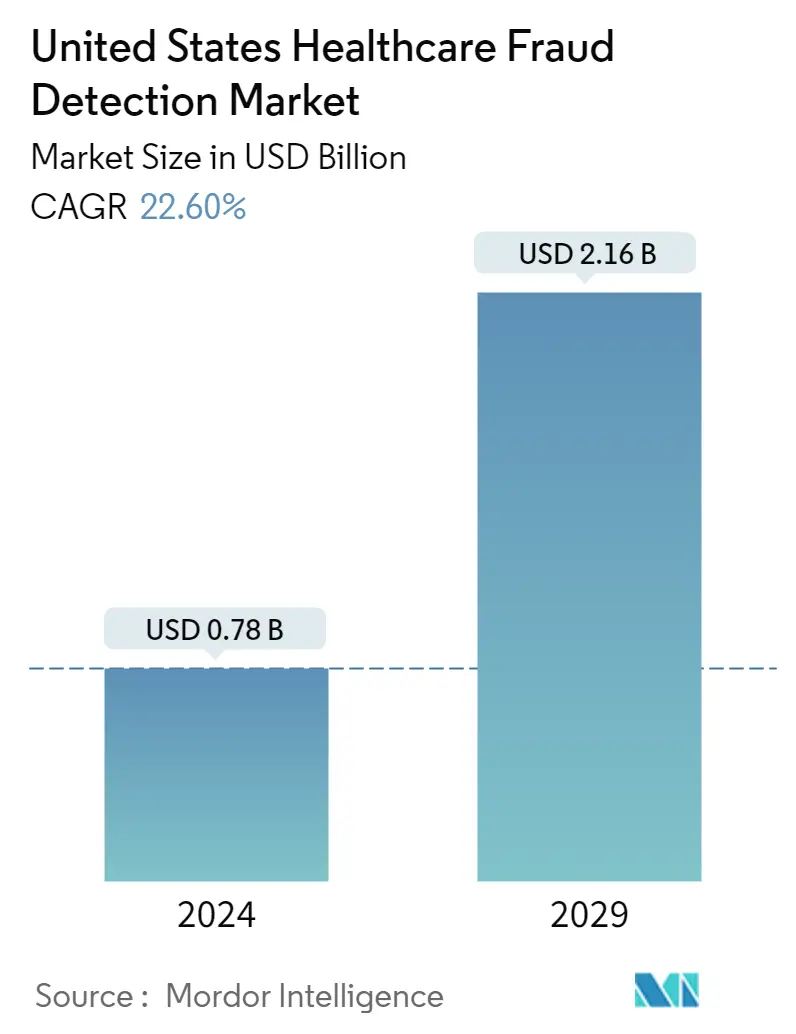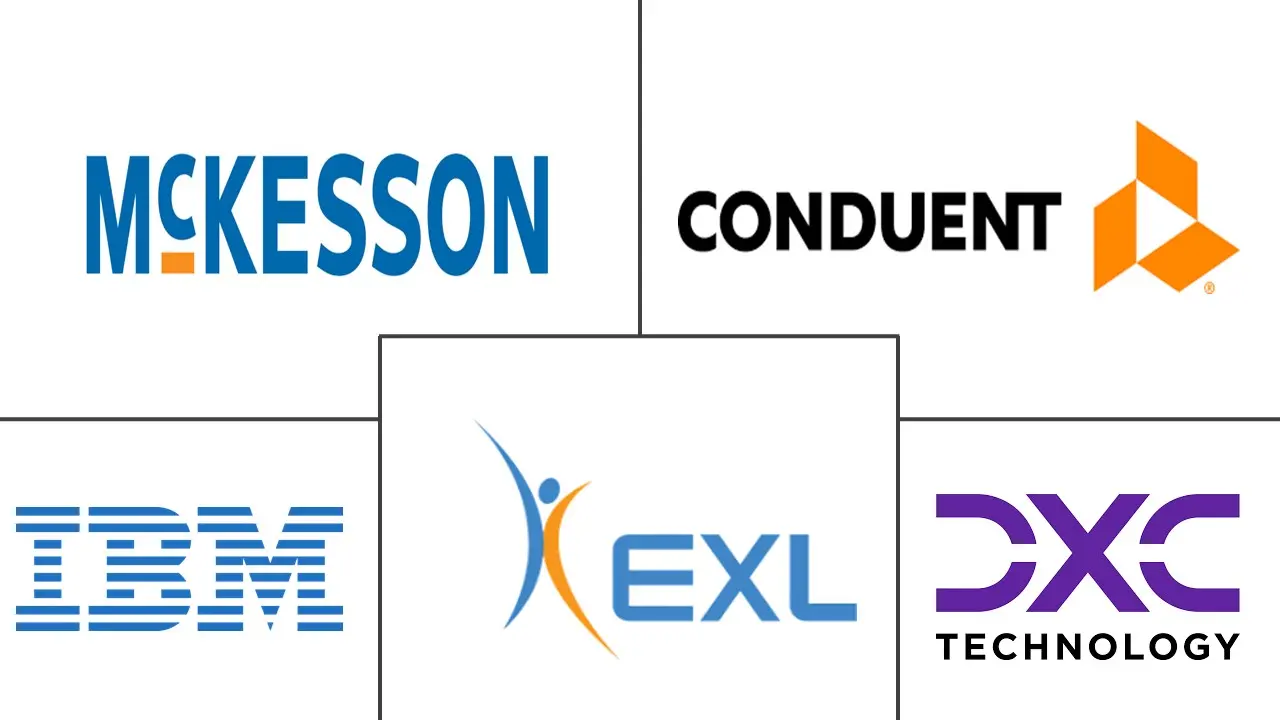Market Size of United States Healthcare Fraud Detection Industry

| Study Period | 2019 - 2029 |
| Base Year For Estimation | 2023 |
| Market Size (2024) | USD 0.78 Billion |
| Market Size (2029) | USD 2.16 Billion |
| CAGR (2024 - 2029) | 22.60 % |
| Market Concentration | Low |
Major Players
*Disclaimer: Major Players sorted in no particular order |
US Healthcare Fraud Detection Market Analysis
The United States Healthcare Fraud Detection Market size is estimated at USD 0.78 billion in 2024, and is expected to reach USD 2.16 billion by 2029, growing at a CAGR of 22.60% during the forecast period (2024-2029).
The COVID-19 epidemic illustrates how public health crises affect emergency departments and hospital systems. The pandemic of COVID-19 had a tremendous impact on healthcare delivery. Urgent adjustments in billing codes, telehealth, and prescriptions enabled health care systems to successfully modify care delivery methods. These quick modifications, however, posed potential vulnerabilities for fraud and waste. According to the study published in May 2021, titled "The COVID-19 Epidemic As A Catalyst For Health Care Fraud" coronavirus aid, relief, and economic security (cares) acted would shortly provide funds to an estimated USD140 million United States households. This, combined with the heightened susceptibility to fraud that came with many people's dread, raises the possibility that covid-19 had been the newest consumer-facing fraud hot zone. Such spreads were common in the United States during the pandemic. In addition, in May 2021, the Department of Justice announced criminal charges against 14 defendants in seven federal districts across the United States, including 11 newly charged defendants and three charged in superseding indictments, for their alleged participation in various health care fraud schemes that exploited the COVID-19 pandemic and resulted in over USD 143 million in false billings. Hence, during a pandemic, healthcare fraud increased thereby growing the adoption of healthcare fraud detection systems and thus positively impacting the market.
The major factors attributing to the growth of the United States healthcare fraud detection market are increasing fraudulent activities in the United States healthcare, growing pressure to increase operational efficiency and reduce healthcare spending, and the prepayment review model. For instance, in September 2020, the Department of Health and Human Services Office charged 345 defendants in 51 judicial districts with participating in healthcare fraud schemes involving more than USD 6 billion in alleged losses to federal healthcare programs
According to the National Health Care Anti-Fraud Association, health insurance fraud in the United States cost around USD 80 billion per year to consumers. Criminals are looking forward to profiting from the people across the country. As most people in the country have health insurance, free medical treatments or complimentary consultation offers are being stolen. Additionally, in July 2022, the Department of Justice announced criminal charges against 36 individuals in 13 federal districts around the United States for alleged fraudulent telemedicine, cardiovascular and cancer genetic testing, and durable medical equipment (DME) scams totaling more than USD 1.2 billion. Thus, an increase in healthcare fraud in the country is expected to rise in demand for the healthcare fraud detection market.
Such cases of fraud in health insurance are causing damage to the medical history of people. A few years back, it was difficult for healthcare providers to identify the fraud, as criminals were using all types of patient identifications and insurance information. According to the National Health Care Anti-Fraud Association's (NHCAA) Consumer Information section, updated in 2021, the United States spends more than USD 2.27 trillion on health care annually. According to the NHCAA, USD 10 billion is lost each year due to health care fraud, and USD 54 billion is anticipated to be conned and stolen in the United States. These actions, as well as the loss of income as a result of fraud and illicit operations, make healthcare fraud the country's most serious problem. Over the projected period, this is expected to fuel demand for healthcare fraud detection systems. Due to such frauds, patients are compelled to pay higher premiums. Therefore, the United States healthcare department is currently more focused on the reduction of such cases by implementing fraud detection technology. Therefore, it is believed that due to the rising fraudulent activities in the United States healthcare department, the market studied may grow in the future. However, the lack of skilled healthcare IT labors in the country may restrain the market growth over the forecast period.
US Healthcare Fraud Detection Industry Segmentation
As per the scope of the report, the term healthcare fraud detection refers to solutions that are helpful in earlier detection of errors in claim submissions, duplication of claims, etc., to minimize healthcare spending and improve efficiency. The United States Healthcare Fraud Detection Market is segmented by Type (Descriptive Analytics, Predictive Analytics, Prescriptive Analytics), Application (Review of Insurance Claims and Payment Integrity), and End User (Private Insurance, Payers, Government Agencies, Other End Users). The report offers the value (in USD million) for the above segments.
| By Type | |
| Descriptive Analytics | |
| Predictive Analytics | |
| Prescriptive Analytics |
| By Application | |
| Review of Insurance Claims | |
| Payment Integrity |
| By End User | |
| Private Insurance Payers | |
| Government Agencies | |
| Other End Users |
United States Healthcare Fraud Detection Market Size Summary
The United States healthcare fraud detection market is poised for significant growth, driven by the increasing prevalence of fraudulent activities within the healthcare sector and the urgent need to enhance operational efficiency and reduce healthcare expenditures. The COVID-19 pandemic has exacerbated vulnerabilities in healthcare systems, leading to a surge in fraudulent activities, which in turn has accelerated the adoption of fraud detection technologies. The market is characterized by a moderate level of competition, with major players such as Conduent Inc., DXC Technology Company, EXL (Scio Health Analytics), IBM, and McKesson leading the charge. These companies are leveraging advanced technologies, including AI and machine learning, to improve fraud detection capabilities and streamline insurance claim reviews, which are critical in combating healthcare fraud.
The market's expansion is further supported by strategic initiatives and technological advancements aimed at automating and enhancing fraud detection processes. For instance, platforms like Artivatic's ALFRED-AI HEALTH CLAIMS are being developed to offer sophisticated risk assessment and decision-making tools. Despite the promising growth trajectory, the market faces challenges, including a shortage of skilled healthcare IT professionals, which could potentially hinder its progress. Nonetheless, the ongoing efforts to implement robust fraud detection systems are expected to significantly mitigate the financial losses attributed to healthcare fraud, thereby fostering a more secure and efficient healthcare environment in the United States.
United States Healthcare Fraud Detection Market Size - Table of Contents
-
1. MARKET DYNAMICS
-
1.1 Market Overview
-
1.2 Market Drivers
-
1.2.1 Increasing Fraudulent Activities in the US Healthcare Sector
-
1.2.2 Growing Pressure to Increase the Operation Efficiency and Reduce Healthcare Spending
-
1.2.3 Prepayment Review Model
-
-
1.3 Market Restraints
-
1.3.1 Lack of Skilled Healthcare IT Labors in the Country
-
-
1.4 Porter's Five Forces Analysis
-
1.4.1 Threat of New Entrants
-
1.4.2 Bargaining Power of Buyers/Consumers
-
1.4.3 Bargaining Power of Suppliers
-
1.4.4 Threat of Substitute Products
-
1.4.5 Intensity of Competitive Rivalry
-
-
-
2. MARKET SEGMENTATION (Market Size by Value - USD Million)
-
2.1 By Type
-
2.1.1 Descriptive Analytics
-
2.1.2 Predictive Analytics
-
2.1.3 Prescriptive Analytics
-
-
2.2 By Application
-
2.2.1 Review of Insurance Claims
-
2.2.2 Payment Integrity
-
-
2.3 By End User
-
2.3.1 Private Insurance Payers
-
2.3.2 Government Agencies
-
2.3.3 Other End Users
-
-
United States Healthcare Fraud Detection Market Size FAQs
How big is the United States Healthcare Fraud Detection Market?
The United States Healthcare Fraud Detection Market size is expected to reach USD 0.78 billion in 2024 and grow at a CAGR of 22.60% to reach USD 2.16 billion by 2029.
What is the current United States Healthcare Fraud Detection Market size?
In 2024, the United States Healthcare Fraud Detection Market size is expected to reach USD 0.78 billion.

